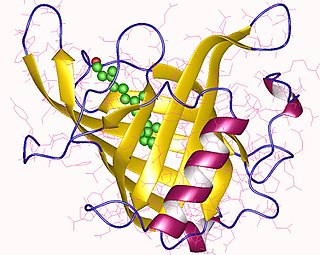Related Research Articles

The thymus is a specialized primary lymphoid organ of the immune system. Within the thymus, T cells mature. T cells are critical to the adaptive immune system, where the body adapts specifically to foreign invaders. The thymus is composed of two identical lobes and is located in the anterior superior mediastinum, in front of the heart and behind the sternum. Each lobe of the thymus can be divided into a central medulla and a peripheral cortex which is surrounded by an outer capsule.

A T cell is a type of lymphocyte, which develops in the thymus gland and plays a central role in the immune response. T cells can be distinguished from other lymphocytes by the presence of a T-cell receptor on the cell surface. These immune cells originate as precursor cells, derived from bone marrow, and develop into several distinct types of T cells once they have migrated to the thymus gland. T cell differentiation continues even after they have left the thymus.

A cytotoxic T cell is a T lymphocyte that kills cancer cells, cells that are infected, or cells that are damaged in other ways.

Ruminantia is a taxon within the order Artiodactyla that includes many of the well-known large grazing or browsing mammals: among them cattle, goats, sheep, deer, and antelope. All members of the Ruminantia employ foregut fermentation and are ruminants: they digest food in two steps, chewing and swallowing in the normal way to begin with, and then regurgitating the semidigested cud to rechew it and thus extract the maximum possible food value.

Chloride channels are a superfamily of poorly understood ion channels specific for chloride. These channels may conduct many different ions, but are named for chloride because its concentration in vivo is much higher than other anions. Several families of voltage-gated channels and ligand-gated channels have been characterized in humans.

Terminal deoxynucleotidyl transferase (TdT), also known as DNA nucleotidylexotransferase (DNTT) or terminal transferase, is a specialized DNA polymerase expressed in immature, pre-B, pre-T lymphoid cells, and acute lymphoblastic leukemia/lymphoma cells. TdT adds N-nucleotides to the V, D, and J exons of the TCR and BCR genes during antibody gene recombination, enabling the phenomenon of junctional diversity. In humans, terminal transferase is encoded by the DNTT gene. As a member of the X family of DNA polymerase enzymes, it works in conjunction with polymerase λ and polymerase μ, both of which belong to the same X family of polymerase enzymes. The diversity introduced by TdT has played an important role in the evolution of the vertebrate immune system, significantly increasing the variety of antigen receptors that a cell is equipped with to fight pathogens. Studies using TdT knockout mice have found drastic reductions (10-fold) in T-cell receptor (TCR) diversity compared with that of normal, or wild-type, systems. The greater diversity of TCRs that an organism is equipped with leads to greater resistance to infection. Although TdT was one of the first DNA polymerases identified in mammals in 1960, it remains one of the least understood of all DNA catalysis enzymes. In 2016–18, TdT was discovered to demonstrate in trans template dependant behaviour in addition to its more broadly known template independent behaviour

Bone morphogenetic protein 5 is a protein that in humans is encoded by the BMP5 gene.
Bovine alphaherpesvirus 5 (BoHV-5) is a virus species of the genus Varicellovirus and subfamily Alphaherpesvirinae. It causes meningoencephalitis and respiratory disease in cattle and sheep. As with all herpes viruses latent infection can occur, with recrudescence at times of stressed and/or immunosuppression. Sites of latency include the CNS and mucosae of the nose and trachea. The disease has been documented in South America, the United States, Australia, Germany and Hungary. Caused by: BHV-5 — Bovine Encephalitis Virus — Bovine Encephalitis Herpesvirus

Thy-1 or CD90 is a 25–37 kDa heavily N-glycosylated, glycophosphatidylinositol (GPI) anchored conserved cell surface protein with a single V-like immunoglobulin domain, originally discovered as a thymocyte antigen. Thy-1 can be used as a marker for a variety of stem cells and for the axonal processes of mature neurons. Structural study of Thy-1 led to the foundation of the Immunoglobulin superfamily, of which it is the smallest member, and led to some of the initial biochemical description and characterization of a vertebrate GPI anchor and also the first demonstration of tissue specific differential glycosylation.
Collectins (collagen-containing C-type lectins) are a part of the innate immune system. They form a family of collagenous Ca2+-dependent defense lectins, which are found in animals. Collectins are soluble pattern recognition receptors (PRRs). Their function is to bind to oligosaccharide structure or lipids that are on the surface of microorganisms. Like other PRRs they bind pathogen-associated molecular patterns (PAMPs) and danger-associated molecular patterns (DAMPs) of oligosaccharide origin. Binding of collectins to microorganisms may trigger elimination of microorganisms by aggregation, complement activation, opsonization, activation of phagocytosis, or inhibition of microbial growth. Other functions of collectins are modulation of inflammatory, allergic responses, adaptive immune system and clearance of apoptotic cells.
Chemokine ligand 16 (CCL16) is a small cytokine belonging to the CC chemokine family that is known under several pseudonyms, including Liver-expressed chemokine (LEC) and Monotactin-1 (MTN-1). This chemokine is expressed by the liver, thymus, and spleen and is chemoattractive for monocytes and lymphocytes. Cellular expression of CCL16 can be strongly induced in monocytes by IL-10, IFN-γ and bacterial lipopolysaccharide. Its gene is located on chromosome 17, in humans, among a cluster of other CC chemokines. CCL16 elicits its effects on cells by interacting with cell surface chemokine receptors such as CCR1, CCR2, CCR5 and CCR8.

Chemokine ligand 17 (CCL17) is a small cytokine belonging to the CC chemokine family is also known as thymus and activation regulated chemokine (TARC). CCL17 is expressed constitutively in thymus, but only transiently in phytohemagglutinin-stimulated peripheral blood mononuclear cells. This chemokine specifically binds and induces chemotaxis in T cells and elicits its effects by interacting with the chemokine receptor CCR4. The gene for CCL17 is located on chromosome 16, in humans, along with other chemokines called CCL22 and CX3CL1.

Collectin-10, also known as collectin liver 1, is a collectin protein that in humans is encoded by the COLEC10 gene. Its structure is similar to mannan-binding lectin (MBL).
The RAR-related orphan receptors (RORs) are members of the nuclear receptor family of intracellular transcription factors. There are three forms of ROR, ROR-α, -β, and -γ and each is encoded by a separate gene RORA, RORB, and RORC respectively. The RORs are somewhat unusual in that they appear to bind as monomers to hormone response elements as opposed to the majority of other nuclear receptors which bind as dimers.

In enzymology, a 6,7-dihydropteridine reductase (EC 1.5.1.34, also Dihydrobiopterin reductase) is an enzyme that catalyzes the chemical reaction

RAR-related orphan receptor gamma (RORγ) is a protein that in humans is encoded by the RORC gene. RORγ is member of the nuclear receptor family of transcription factors. It is mainly expressed in immune cells and it also regulates circadian rhythms. It may be involved in the progression of certain types of cancer.

Thymus-specific serine protease is an enzyme that in humans is encoded by the PRSS16 gene.
Collectin of 43 kDa (CL-43) is a collectin protein that acts as an antigen recognition protein. When an agent, zymosan, was injected into the tunicate Styela plicata, secretion of this collectin was tripled within 96 hours.

Retinol-binding proteins (RBP) are a family of proteins with diverse functions. They are carrier proteins that bind retinol. Assessment of retinol-binding protein is used to determine visceral protein mass in health-related nutritional studies.

Collectin-12, also known as collectin subfamily member 12, is a collectin protein that in humans is encoded by the COLEC12 gene.
References
- ↑ Holmskov, Uffe; Skjoedt, Karsten; Reid, Kenneth B. M.; Bendixen, Christian; Vitved, Lars; Moeller, Vivi; Holm, Dorte; Hansen, Soren (November 15, 2002). "CL-46, a Novel Collectin Highly Expressed in Bovine Thymus and Liver". The Journal of Immunology. 169 (10): 5726–5734. doi: 10.4049/jimmunol.169.10.5726 . PMID 12421952.
| This immunology article is a stub. You can help Wikipedia by expanding it. |